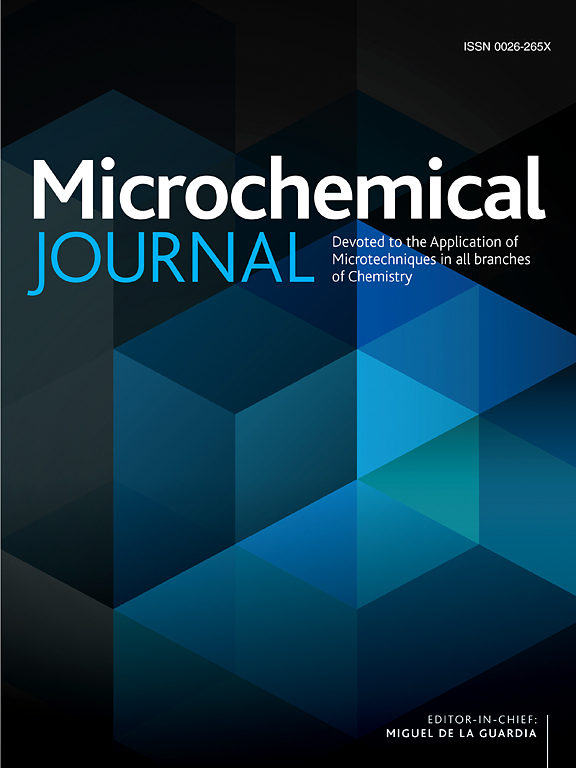Enzyme-responsive aptasensing based on the ATP aptamer and benzothiazole-coumarin G-quadruplex fluorescent probe for label-free detection of adenosine deaminase activity and its inhibitor
IF 4.9
2区 化学
Q1 CHEMISTRY, ANALYTICAL
引用次数: 0
Abstract
Adenosine deaminase (ADA) is a vital enzyme for regulating the biological process in humans and its abnormal expression level is related to various severe diseases. Nevertheless, conventional approaches for detecting ADA activity are hindered by the drawbacks of complexity and limited detection performances. To address these challenges, we here designed an ADA-responsive aptasensing strategy based on a synthesized benzothiazole-coumarin G-quadruplex (G4) fluorescent probe, which can bind to the G-rich ATP aptamer (G-APA) and form the high-contrast fluorescent complex (S1/G-APA). While the fluorescence of S1/G-APA could be quenched by ATP competition due to the allosteric process, the deamination in ATP catalyzed by ADA would recover the fluorescence of S1/G-APA and allow a facile, turn-on, label-free, and selective detection of ADA activity. This proposed method exhibits favorable detection performances for ADA activity analysis with a wide detection linear range varied from 1 to 100 U/L and a detection limit of 0.82 U/L. Meanwhile, it can be applied for ADA inhibitor (DCF) evaluation and provide a turn-off and sensitive detection performances. Inspired by these detection efficacies, the serum samples spiked with ADA and DCF have been investigated to present the satisfied recovery rates and detection reliability. Collectively, this method will provide a promising way for portable and efficient ADA activity quantification and evaluating the inhibition efficiencies of ADA inhibitors, which hold the potential in promoting ADA-related sensing and pharmaceutical research.

基于 ATP aptamer 和苯并噻唑-香豆素 G-四倍体荧光探针的酶响应式适配传感技术,用于无标记检测腺苷脱氨酶活性及其抑制剂
腺苷脱氨酶(ADA)是调节人体生物过程的一种重要酶,其异常表达水平与各种严重疾病有关。然而,检测 ADA 活性的传统方法存在复杂性和检测性能有限等缺点。为了解决这些难题,我们在此设计了一种基于合成的苯并噻唑-香豆素 G-四重链(G4)荧光探针的 ADA 响应型适配体传感策略,该探针可与富含 G 的 ATP 适配体(G-APA)结合并形成高对比度的荧光复合物(S1/G-APA)。由于异构过程,S1/G-APA 的荧光会被 ATP 竞争淬灭,而 ADA 催化的 ATP 脱氨会恢复 S1/G-APA 的荧光,从而实现对 ADA 活性的简便、开启、无标记和选择性检测。该方法的检测线性范围为1-100 U/L,检出限为0.82 U/L。同时,该方法还可用于 ADA 抑制剂(DCF)的评价,并具有关断和灵敏的检测性能。在此基础上,对添加了ADA和DCF的血清样品进行了检测,结果表明回收率和检测可靠性均令人满意。总之,该方法将为便携、高效的 ADA 活性定量和 ADA 抑制剂的抑制效率评估提供一种可行的方法,有望促进 ADA 相关的传感和药物研究。
本文章由计算机程序翻译,如有差异,请以英文原文为准。
求助全文
约1分钟内获得全文
求助全文
来源期刊

Microchemical Journal
化学-分析化学
CiteScore
8.70
自引率
8.30%
发文量
1131
审稿时长
1.9 months
期刊介绍:
The Microchemical Journal is a peer reviewed journal devoted to all aspects and phases of analytical chemistry and chemical analysis. The Microchemical Journal publishes articles which are at the forefront of modern analytical chemistry and cover innovations in the techniques to the finest possible limits. This includes fundamental aspects, instrumentation, new developments, innovative and novel methods and applications including environmental and clinical field.
Traditional classical analytical methods such as spectrophotometry and titrimetry as well as established instrumentation methods such as flame and graphite furnace atomic absorption spectrometry, gas chromatography, and modified glassy or carbon electrode electrochemical methods will be considered, provided they show significant improvements and novelty compared to the established methods.
文献相关原料
公司名称
产品信息
索莱宝
ATP
麦克林
Glucose
阿拉丁
Glutathione
 求助内容:
求助内容: 应助结果提醒方式:
应助结果提醒方式:


